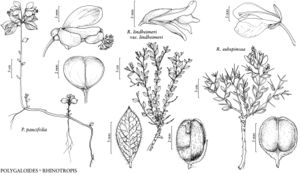Polygaloides paucifolia
J. Bot. Res. Inst. Texas 5: 134. 2011.
Herbs 0.5–1.5 (–2) dm. Leaves: petiole 4–10 mm (to almost sessile proximally); leaves proximally highly reduced, scalelike, 2–8 mm, distally with 3–6 well-developed leaves, somewhat clustered; blade elliptic to ovate, 15–40 (–50) × 10–25 mm, base cuneate, apex rounded, obtuse, or acute, surfaces often glabrous, except pubescent adaxially on midrib and margins densely incurved-ciliolate, sometimes densely pubescent throughout. Inflorescences: peduncle (0–) 1–2 cm; bracts ovate. Pedicels 10–20 mm, glabrous. Cleistogamous flowers usually present later in season, usually on short, erect, rarely leafy, bracteate stems proximally, 2 mm. Chasmogamous flowers 15–23 mm; sepals 4–6 mm; wings obovate or spatulate; keel 10–20 mm. Capsules obovoid or subglobose, 5–8 × 5–8 mm. Seeds 2.5–3.5 mm; aril 1.5–3.5 mm, lobes 1/2 to as long as seed. 2n = 34.
Phenology: Flowering spring–early summer(–mid summer).
Habitat: Sandy, limestone, or granite soils, coniferous and/or mixed forests on moist soils, wooded bogs.
Elevation: 50–700 m.
Distribution
Alta., Man., N.B., Ont., Que., Sask., Conn., Del., Ga., Ill., Ind., Ky., Maine, Md., Mass., Mich., Minn., N.H., N.J., N.Y., N.C., Ohio, Pa., R.I., S.C., Tenn., Vt., Va., W.Va., Wis.
Discussion
Polygaloides paucifolia is isolated and morphologically distinct from its closest relatives in Europe and northern Africa, perhaps being a vicariant relict of a historical circumboreal flora. Its creeping herbaceous habit with relatively thin leaves and large showy crest set P. paucifolia apart from the Old World taxa (subshrubs or shrubs to 1 m with subcoriaceous leaves and small, fairly inconspicuous crest); the form of the stigma, the glanduliform disc at the base of the flower, and the few-flowered inflorescences morphologically unite the taxa.
Polygaloides paucifolia is considered to be extirpated in Newfoundland.
Selected References
None.
